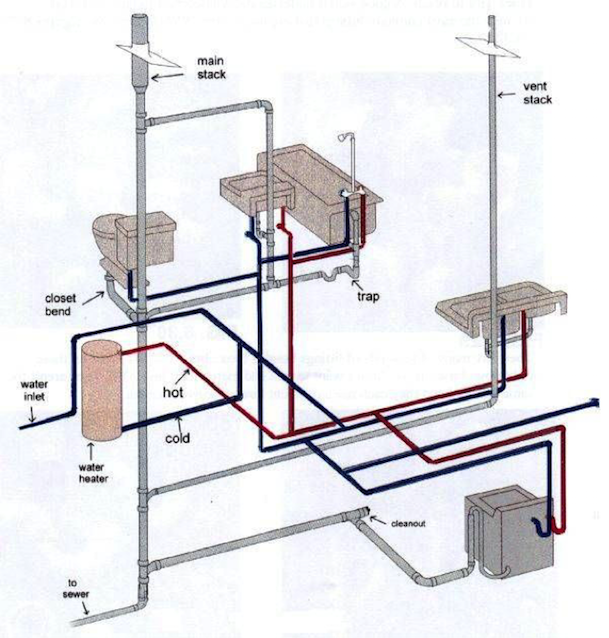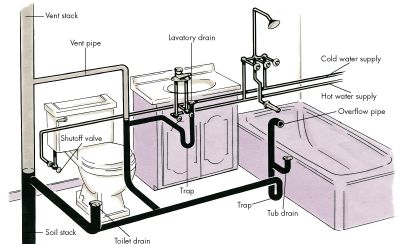Just how do you feel when it comes to The Inner Workings of Your Home's Plumbing?

Comprehending exactly how your home's plumbing system works is crucial for every single homeowner. From supplying tidy water for alcohol consumption, food preparation, and showering to securely eliminating wastewater, a well-maintained pipes system is essential for your family members's health and convenience. In this comprehensive overview, we'll check out the complex network that comprises your home's pipes and deal pointers on maintenance, upgrades, and taking care of common issues.
Intro
Your home's plumbing system is greater than just a network of pipes; it's a complicated system that guarantees you have accessibility to tidy water and efficient wastewater elimination. Understanding its parts and how they interact can aid you prevent pricey repair work and ensure whatever runs efficiently.
Fundamental Components of a Pipes System
Pipes and Tubes
At the heart of your plumbing system are the pipes and tubing that lug water throughout your home. These can be made from different materials such as copper, PVC, or PEX, each with its advantages in regards to durability and cost-effectiveness.
Fixtures: Sinks, Toilets, Showers, etc.
Fixtures like sinks, bathrooms, showers, and bathtubs are where water is used in your house. Understanding how these components link to the pipes system helps in identifying troubles and intending upgrades.
Shutoffs and Shut-off Factors
Valves control the circulation of water in your pipes system. Shut-off shutoffs are essential during emergencies or when you require to make repairs, permitting you to isolate parts of the system without interrupting water flow to the entire house.
Water System
Key Water Line
The main water line attaches your home to the local water supply or an exclusive well. It's where water enters your home and is distributed to various components.
Water Meter and Stress Regulator
The water meter procedures your water usage, while a pressure regulator makes certain that water flows at a risk-free pressure throughout your home's plumbing system, preventing damages to pipes and fixtures.
Cold Water vs. Warm water Lines
Understanding the distinction in between cold water lines, which provide water straight from the main, and hot water lines, which bring warmed water from the hot water heater, assists in troubleshooting and preparing for upgrades.
Water drainage System
Drain Pipes Water Lines and Traps
Drain pipelines carry wastewater away from sinks, showers, and commodes to the sewer or septic tank. Traps stop sewage system gases from entering your home and likewise catch debris that could create obstructions.
Air flow Pipes
Ventilation pipelines enable air right into the drainage system, avoiding suction that can reduce drainage and create catches to vacant. Appropriate ventilation is necessary for keeping the honesty of your pipes system.
Relevance of Correct Drainage
Making certain correct drain avoids back-ups and water damages. Consistently cleaning up drains pipes and maintaining catches can stop expensive repair work and prolong the life of your pipes system.
Water Heating Unit
Sorts Of Hot Water Heater
Water heaters can be tankless or typical tank-style. Tankless heating systems warm water as needed, while storage tanks keep heated water for immediate usage.
Exactly How Water Heaters Attach to the Plumbing System
Recognizing exactly how hot water heater link to both the cold water supply and warm water distribution lines aids in identifying problems like not enough hot water or leakages.
Upkeep Tips for Water Heaters
Routinely purging your hot water heater to get rid of debris, inspecting the temperature level settings, and checking for leakages can expand its life expectancy and improve energy performance.
Common Plumbing Problems
Leaks and Their Reasons
Leaks can take place as a result of maturing pipes, loosened installations, or high water pressure. Addressing leakages immediately avoids water damage and mold growth.
Clogs and Clogs
Clogs in drains pipes and toilets are frequently triggered by flushing non-flushable items or a build-up of grease and hair. Utilizing drainpipe displays and bearing in mind what goes down your drains can stop obstructions.
Signs of Pipes Problems to Watch For
Low tide stress, slow-moving drains pipes, foul odors, or unusually high water expenses are indications of prospective pipes issues that should be dealt with promptly.
Plumbing Upkeep Tips
Normal Examinations and Checks
Arrange yearly pipes evaluations to catch concerns early. Look for signs of leaks, deterioration, or mineral accumulation in faucets and showerheads.
DIY Maintenance Tasks
Straightforward tasks like cleansing tap aerators, checking for commode leakages utilizing dye tablet computers, or shielding exposed pipes in cold climates can stop significant pipes problems.
When to Call an Expert Plumbing
Know when a pipes issue requires professional know-how. Trying complicated repairs without correct understanding can lead to more damage and greater repair service prices.
Upgrading Your Pipes System
Factors for Upgrading
Updating to water-efficient fixtures or replacing old pipelines can improve water quality, decrease water expenses, and enhance the worth of your home.
Modern Pipes Technologies and Their Advantages
Discover technologies like smart leak detectors, water-saving bathrooms, and energy-efficient hot water heater that can conserve money and lower environmental impact.
Cost Considerations and ROI
Calculate the in advance expenses versus long-lasting cost savings when thinking about plumbing upgrades. Numerous upgrades pay for themselves via reduced utility expenses and less repair work.
Environmental Effect and Conservation
Water-Saving Fixtures and Home Appliances
Setting up low-flow faucets, showerheads, and commodes can dramatically lower water usage without compromising performance.
Tips for Minimizing Water Usage
Easy routines like repairing leaks without delay, taking shorter showers, and running complete tons of washing and meals can conserve water and reduced your energy costs.
Eco-Friendly Plumbing Options
Take into consideration lasting plumbing materials like bamboo for floor covering, which is durable and green, or recycled glass for countertops.
Emergency Readiness
Actions to Take Throughout a Pipes Emergency situation
Know where your shut-off shutoffs are located and how to switch off the water system in case of a burst pipeline or significant leak.
Value of Having Emergency Situation Get In Touches With Handy
Maintain get in touch with details for neighborhood plumbing professionals or emergency solutions conveniently available for fast response throughout a pipes crisis.
DIY Emergency Fixes (When Applicable).
Temporary repairs like using duct tape to patch a leaking pipe or positioning a container under a trickling faucet can lessen damage till an expert plumbing gets here.
Verdict.
Recognizing the composition of your home's plumbing system encourages you to preserve it efficiently, saving money and time on fixings. By complying with normal upkeep routines and remaining educated concerning contemporary plumbing innovations, you can ensure your plumbing system operates successfully for years ahead.
HOW YOUR PLUMBING SYSTEM WORKS
Which Pipes Do What?
Blue lines = fresh water supply entering the building
Red lines = hot water supply entering the building
Grey lines = pipes carrying waste away from the building and venting pipes carrying gases away from the building (through the roof)
YOUR MAIN PLUMBING SYSTEMS
There are two main plumbing systems that support your home s basic plumbing needs one that brings clean water into your home, and one that sends dirty water away from your home. Connected to the toilet, bath, shower, and other faucets in your home, these two systems keep your water flowing in the right directions.
ACCESSING FRESH WATER
Fresh and clean water is brought into your home through the main water supply line . Filtered through one pipe, this water is pressured to flow into the various fixtures in your home at any given time.
This water can be sourced from a well located on your property, a pond or river (mostly cottages), or, as in most cases, from the city s municipal water treatment centre. However, it is important to note that water that is untreated, such as the water siphoned from ponds or rivers, may not be safe to drink. Personal water supplies always need to be treated for hardness and contaminants before consumed.
MUNICIPAL WATER SUPPLIES
Improve taste and odour
Remove sediment
Eliminate hardness
Reduce chlorine
COLD WATER SUPPLY VS. HOT WATER SUPPLY
Cold water flows into your home or building through the service line, which then distributes hot or cold water to your fixtures. This line is most commonly run through a central column that runs floor to floor. Hot water runs in short and straight pipes as the longer the pipeline, the more heat that will be lost in the transfer. Having shorter pipes also allows residents to access hot water more quickly.
WASTE WATER SYSTEM
Your wastewater system is divided into two parts pipes that send wastewater away from your home and venting pipes that send sewer gas away from your home. Sewage water travels through pipes that flush the water and waste towards local sewers that are operated and managed by your city or town. Most sewer systems rely on gravity to move the wastewater to where it needs to go.
The further away from your toilet or sink, the larger wastewater pipes become. This allows for waste to be disposed of from various parts of your home or business at once without pipe blockages. The angle and flow of these pipes are also essential for keeping your waste pipes clear of build up.
https://harrisplumbing.ca/how-your-home-plumbing-system-works/

HOW YOUR PLUMBING SYSTEM WORKS
Which Pipes Do What?
YOUR MAIN PLUMBING SYSTEMS
There are two main plumbing systems that support your home s basic plumbing needs one that brings clean water into your home, and one that sends dirty water away from your home. Connected to the toilet, bath, shower, and other faucets in your home, these two systems keep your water flowing in the right directions.
ACCESSING FRESH WATER
Fresh and clean water is brought into your home through the main water supply line . Filtered through one pipe, this water is pressured to flow into the various fixtures in your home at any given time.
This water can be sourced from a well located on your property, a pond or river (mostly cottages), or, as in most cases, from the city s municipal water treatment centre. However, it is important to note that water that is untreated, such as the water siphoned from ponds or rivers, may not be safe to drink. Personal water supplies always need to be treated for hardness and contaminants before consumed.
MUNICIPAL WATER SUPPLIES
COLD WATER SUPPLY VS. HOT WATER SUPPLY
Cold water flows into your home or building through the service line, which then distributes hot or cold water to your fixtures. This line is most commonly run through a central column that runs floor to floor. Hot water runs in short and straight pipes as the longer the pipeline, the more heat that will be lost in the transfer. Having shorter pipes also allows residents to access hot water more quickly.
WASTE WATER SYSTEM
Your wastewater system is divided into two parts pipes that send wastewater away from your home and venting pipes that send sewer gas away from your home. Sewage water travels through pipes that flush the water and waste towards local sewers that are operated and managed by your city or town. Most sewer systems rely on gravity to move the wastewater to where it needs to go.
The further away from your toilet or sink, the larger wastewater pipes become. This allows for waste to be disposed of from various parts of your home or business at once without pipe blockages. The angle and flow of these pipes are also essential for keeping your waste pipes clear of build up.
https://harrisplumbing.ca/how-your-home-plumbing-system-works/
Do you enjoy reading about The Inner Workings of Your Home's Plumbing? Put feedback further down. We would be glad to find out your opinion about this posting. In hopes that you come back again in the future. Appreciated our write-up? Please quickly share it. Let another person check it out. We thank you for your readership.
Schedule Services